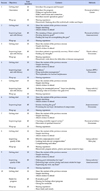Abstract
Purpose
In this study an investigation was done of the effects of a hope enhancement program on hope, self-efficacy, and quality of life for mentally ill persons in day hospitals.
Methods
Research design was a non-equivalent control group pre-post test design as a quasi-experimental study. The participants were selected from mentally ill persons at A day hospital and B day hospital in D city. They were 36 participants (18 in the experimental group and 18 in the control group). The study was conducted from March 17 to April 8, 2014. Data were analyzed using χ2 test, Fisher's exact test, t-test, and independent sample t-test with IBM SPSS/WIN 19.0 Program.
Results
Participants in the hope enhancement program reported increased hope and higher quality of life scores, which were significantly different from those in the control group. Participants in the hope enhancement program also reported increased self-efficacy but it was not significantly different compared to the control group.
Figures and Tables
Notes
References
1. Miller JF, Powers MJ. Development of an instrument to measure hope. Nurs Res. 1988; 37(1):6–10. DOI: 10.1097/00006199-198801000-00002.

2. Kim DS, Moon WH, Ahn SY, Oh HS, Kwon KH, Park MK, et al. Meta-analysis of the research findings concerning functional relationships of explanatory variables to hope. J Korean Acad Nurs. 2004; 34(5):673–684.

3. Song HJ, Hyun MY, Lee EJ. Hope, self-care agency and mental health in patients with chronic schizophrenia. J Korean Acad Psychiatr Ment Health Nurs. 2011; 20(2):180–187.

4. Choe KS, Kim HJ, Noh CH. Hope in people with schizophrenia: concept clarification. J Korean Acad Psychiatr Ment Health Nurs. 2005; 14(4):417–427.
5. Frese FJ, Knight EL, Sake E. Recovery from schizophrenia: with views of psychiatrists, psychologists, and others diagnosed with this disorder. Schizophr Bull. 2009; 35(2):370–380. DOI: 10.1093/schbul/sbn175.

6. Rho ES. A study on the development of a quality of life model of schizophrenic patients [dissertation]. [Seoul]: Chung-Ang University;2000. 121.
7. Magaletta PR, Oliver JM. The hope construct, will, and ways: their relations with self-efficacy, optimism, and general wellbeing. J Clin Psychol. 1999; 55(5):539–551. DOI: 10.1002/(SICI)1097-4679(199905)55:5<539::AID-JCLP2>3.0.CO;2-G.

8. Kim CN, Shin AM, Park KM, Park MH, Kim YA. The effects of hope intervention on the hope and quality of life of cancer patients staying at home and cared in public health center. J Korean Acad Community Health Nurs. 2008; 19(2):177–187.
9. Koh MH. Experience of hope in the clients with chronic schizophrenia. J Korean Acad Nurs. 2005; 35(3):555–564. DOI: 10.4040/jkan.2005.35.3.555.

10. Kirkpatrick H, Landeen J, Woodside H, Byrne C. How people with schizophrenia build their hope. Journal of Psychosocial Nursing Mental Health Service. 2001; 39(1):46–53.

11. Snyder CR. Hope theory: rainbows in the mind. Psychol Inq. 2002; 13(4):249–275. DOI: 10.1207/S15327965PLI1304_01.
12. Herth KA. Enhancing hope in people with a first recurrence of cancer. J Adv Nurs. 2000; 32(6):1431–1441. DOI: 10.1046/j.1365-2648.2000.01619.x.

13. Choe KS, Kim HJ, Noh CH. A preliminary study for the development of an instrument to measure hope in people with schizophrenia. J Korean Acad Psychiatr Ment Health Nurs. 2006; 15(4):392–400.
14. Lee DC. Korea academy of mental health social work spring conference. In : The effects of hope improvement program on hope and family adaptability for mentally illness persons and family: From Korea academy of mental health social work spring conference; 2004 May 3; Daejeon University. Daejeon: Korea Academy of Mental Health Social Work;2004. p. 33–65.
15. Cohen J. Statistical power analysis for behavioral sciences. 2nd ed. Hillsdale NJ: Lawrence Erlbaum Associates;1988. p. 567.
16. Nowtony ML. Assessment of hope in patients with cancer: development of an instrument. Oncol Nurs Forum. 1989; 16(1):57–61.
17. Kim SM, Oh PJ. A study on the hope, health promoting behavior and quality of life in cancer patients. J Korean Acad Adult Nurs. 1996; 8(1):169–179.
18. Hofstetter CR, Sallis JF, Hovell MF. Some health dimensions of self-efficacy: analysis of theoretical specificity. Soc Sci Med. 1990; 31(9):1051–1056. DOI: 10.1016/0277-9536(90)90118-C.

19. Sherer M, Maddux JE, Mercandante B, Prentice-Dunn S, Jacobs B, Rogers RW. The self-efficacy scale: construction and validation. Psychol Rep. 1982; 51(2):663–667. DOI: 10.2466/pr0.1982.51.2.663.

20. Kook SH, Son CN. The development of happy-QoL scale for assessing the quality of life in patients with schizophrenic disorder. Korean J Clin Psychol. 2002; 21(3):665–691.
21. Jo KY. The effects of integrative self-esteem improvement program on self-esteem, interpersonal relationship, and quality of life for persons with mental disorder. J Korean Acad Psychiatr Ment Health Nurs. 2009; 18(4):439–448.
22. King IM. A theory of nursing: systems, concepts, process. New York: John Wiley and Sons;1981. p. 181.
23. Kim KH, Lee YJ, Wang EJ. A meta-analysis on the efficacy of group counseling conducted in Korea. Korean J Couns. 2002; 3(1):47–62.
24. Kim YJ. The effects of interpersonal caring behaviors on selfesteem, hope and life quality of in patients with mental disorder [dissertation]. [Seoul]: Ewha Womans University;2004. 96.
25. Park JS, Oh YJ. The effects of psychosocial intervention on depression, hope and quality of life of home-based cancer patients. J Korean Acad Adult Nurs. 2010; 22(6):594–605.
26. Cho HI. The structural equation modeling analysis of self-efficacy, hope, and depression on academic achievement. J Child Educ. 2010; 19(2):251–271.
27. Park HS, Bae SW, Kim YY. The effects of psychosocial rehabilitation programs on the levels of self-efficacy for mentally disabled persons. J Korean Acad Nurs. 2008; 38(5):704–711. DOI: 10.4040/jkan.2008.38.5.704.

28. Bandura A. Self-efficacy: toward a unifying theory of behavioral change. Psychol Rev. 1977; 84(2):191–215.

29. Park BS, Lim SO, Bae SW. A meta-analysis on the variables related with quality of life among persons with severe mental illness. Ment Health Soc Work. 2013; 41(3):63–92.
30. Jung SY. A study on the development and effectiveness of integrated rehabilitation program for the mentally disordered in community: a 6 months follow-up study. Ment Health Soc Work. 2002; 14:127–163.




 PDF
PDF ePub
ePub Citation
Citation Print
Print






 XML Download
XML Download